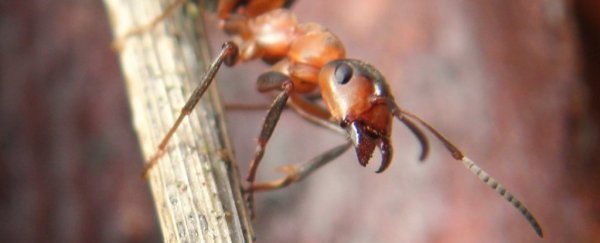We like to think the human brain is special and superior, but even the smallest brains on Earth occasionally show remarkable similarities to our own.
When wood ants (Formica rufa) store visual memories in their brains, new research suggests they break the rules of symmetry: One side of the tiny critter's brain appears to store short-term memories, while the other holds on to them for longer.
This is known as neural lateralisation, and it appears to be closely tied to the formation of memories in animals. In human brains, for instance, spatial memory and musical processing is mainly confined to the right side, while language is mostly on the left side, although there is lots of communication and crossover.
Perhaps the same is true of the lowly ant.
"To our knowledge, this is the first demonstration of lateralised visual memory formation in an insect," the authors write, "with broad implications for our understanding of visual memories in insects and the evolution of lateralisation in memory formation."
Once upon a time, scientists actually thought we were the only species carrying around two distinct hemispheres upstairs, each specialised for various functions and behaviours.
Now, of course, we know a whole better. Asymmetry of brain function is widespread amongst vertebrates, and it's probably been there for some time now, emerging very early on in their evolution.
And that might go for invertebrates, too. Recent research on social bees and their memories of scent suggests these creatures are allocating functions to the left or right side. While most research thus far has focused on the scent memory of bees, it's been unclear whether this lateralisation exists across other types of memory and in other insect species.
Using wood ants - an insect famous for visual navigation - researchers carried out a classic conditioning experiment. When shown a blue object, the ants were allowed to touch a droplet of sugar with either their right or left antenna before tasting it.
Like Pavlov's salivating dog, these critters were trained to respond to the visual cue, and this association was then tested after 10 minutes, an hour, and a day later. If the ants extended their mouths at the sight of the blue object, this was deemed a sign of thirst.
In the end, when ants were trained with just the right antenna, they demonstrated thirst at 10 minutes with a gradually weakening effect as time went on.
On the other hand, ants trained with just the left antenna showed no response at 10 minutes or even an hour. A day later, however, they showed strong signs of thirst.
"We show that a brief contact between a sugar reward and either the right or left antenna is sufficient to produce a lateralised memory, even though the visual cue is visible to both eyes throughout training and testing," the authors write.
"Reinforcement given to the right antenna induced short-term memories, whereas reinforcement given to the left antenna induced long-term memories."
If they're right, and these different types of memory are indeed stored on different sides of the ant's brain, it suggests memory lateralisation may have evolved multiple times in the distant past.
There's a theory it may even arise in creatures that are more social, although this is still being fiercely debated.
Research on olfactory memory and lateralisation in social bees, however, does suggest something oddly similar. Stronger memories appear to form when the right antenna is used, while long-term memories are formed in response to inputs from the bee's left antennae.
There seems to be a pattern here and it's worth exploring further, if only to figure out why asymmetrical brains like our own seem to be so advantageous.
Without knowing more about insect lineages, it's hard to say whether memory lateralisation has evolved independently in ants and social bees, or if it was present in a common ancestor but lost in solitary bees.
Having two distinct hemispheres might reduce conflicting information or help rid the brain of some redundancy, which may be especially important for smaller noggins that need to save energy and space.
It's also possible that retaining long-term memories on one side allows room for new short-term memories to form; there's a lot more here that scientists are yet to discover.
The study was published in the Proceedings of the Royal Society B.
